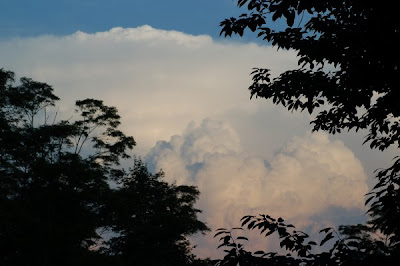
Usually, when you look off the point of our ridge, you see another end of Droop Mountain, but Monday afternoon, these impressive thunderheads rose off the Greenbrier River as we watched. I've never seen anything quite like it here.
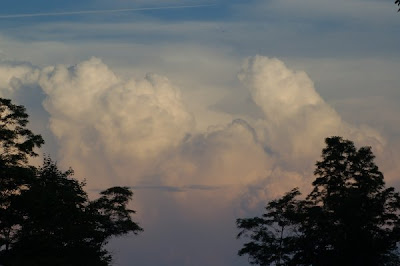
Observations on Appalachia, knitting, sewing, fiber distractions, natural history, literature, Old-Time music, and Linux.

Usually, when you look off the point of our ridge, you see another end of Droop Mountain, but Monday afternoon, these impressive thunderheads rose off the Greenbrier River as we watched. I've never seen anything quite like it here.


In addition to Dogbane Beetle and Sehirus cinctus, a burrower bug, the Indian Hemp in the yard also plays host to the Milkweed Bugs, Oncopeltus fasciatus. They are big (~2 cm), colorful heteropterans, easy to raise up from "pups" on milkweed seeds. This has made them favorites among amateur naturalists, kids, and insect physiologists.
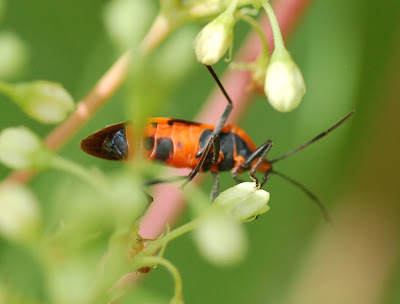


I found several of these pretty little cydnids, Sehirus cinctus, on Indian hemp, Apocynum cannabinum, on the point of our ridge. They're small (around 5 mm), and shiny black, making natural light photography a challenge. They're fairly common, and a string search shows they are popular creatures on the Internet. There are many on-line articles and pdf "reprints" available on their behavior and chemistry. Here are a couple of photo-rich html links:


Although the Luna Moth on last week's laundry was easier to photograph, I was equally excited to see this little Geocoris, a tiny, predaceous heteropteran. About 4 mm long, he was fast-moving and hard to photograph, and he didn't stay long.
Bigeyed bugs, Geocoris spp., are among the most abundant and important predaceous insects in many cropping systems in the U.S. There are approximately 19 species that inhabit North America. Of these, G. punctipes and G. pallens are the most common. Geocoris spp. are known to feed on plants, however they rarely cause economic damage.
The most abundant big-eyed bug in Florida and the southeastern United States is G. punctipes (Say). McGregor and McDonough (1917) reported the life history of G. punctipes at Batesburg, South Carolina, finding the average development time from egg to adult was 30 days. Nymphs consumed an average of 47 mites, and adults an average of 83 "red spider" mites on cotton per day. York (1944) reported that adult Geocoris required either free moisture or plant moisture as well as insect prey. Sweet (1960) found that Geocoris adults can survive on sunflower seeds and water, without insect food.


I was poking around, looking for the context of J. B. S. Haldane's quote about beetles, and discovered, on Wikiquote.org, that it is apocryphal. Haldane's quote is often expressed thus: The Creator, if He exists, has "an inordinate fondness for beetles." Now, it seems to me that fondness for the species-rich insect order Coleoptera could never be inordinate. Look at these gaudy chrysomelid beetles, possibly Dogbane Beetles, Chrysochus auratus. Who could help but be fond of them?
In my searches I also found a website called An Inordinate Fondness for Beetles, and a theological speculation on The Real Reason for the Fall. This dialogue suggests we might still be in Paradise if Adam and Eve had shown a bit more interest in the details of Creation.
God: And here's the next species, one I'm particularly proud of...
Adam: Beetle.
God: Excellent. Now here's another...
Adam: Beetle.
God: No, you just named the last one "beetle". This one is quite
different -- look at the pattern on the wing cases, and the shape
of the antennae...
Adam: Beetle.
God: Well, OK, though they certainly look different to Me. Now, the
next species is --
Adam: Beetle.
(credits: Ken Cox)
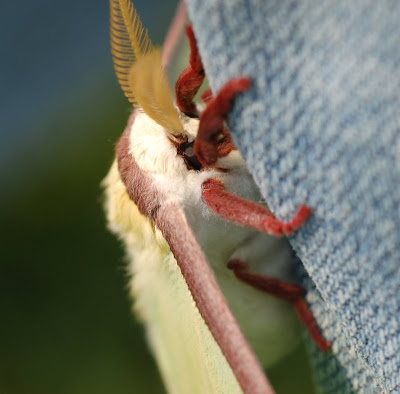
There are many advantages to hanging the laundry on the clothesline--it saves energy, the sun has a bleaching effect on white fabric, and your clothes have that "outdoor fresh smell" made famous by fabric softener commercials. The best thing, though, is that the clothesline is a perfect way to meet wildlife. This Luna Moth emerged from its cocoon and chose these drying jeans to climb on and inflate its wings with haemolymph. It stayed there all afternoon, until I moved it to the locust clothesline post--after all, the clothes were dry, and so were its wings. It eventually flew, like a bird, into the cherry tree, and later visited me at the porch light.

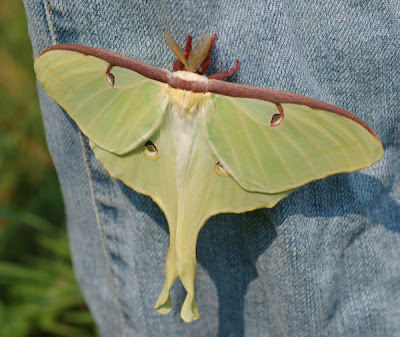
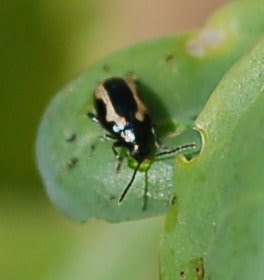
Earlier this month, I posted a photo of the Garden Flea Hopper, a tiny mirid that attacks seedlings of all sorts. Today's photo shows a flea beetle (probably the striped flea beetle mentioned below), which is also tiny, also hops, and also damages seedlings in the garden. Some years, these critters kill off my tomato and cabbage seedlings as soon as I set them out, but this year, they haven't been so bad, and now, their season is just about over. Here are a few flea beetle links.
Description: "Flea beetle" is a generic name applied to many species of small jumping beetles commonly seen early in the gardening season. Some species are general feeders while others have a more restricted host range. All flea beetle life stages are completed underground. Only the adults are commonly seen by gardeners and vegetable producers.
Flea beetles may be somewhat elongate to oval in shape, and vary in color, pattern, and size. For instance, potato flea beetles (Epitrix cucumeris) tend to be more oval, blackish, and about 1/16 inch long.
Striped flea beetles (Phyllotreta striolata) are more elongate and dark with yellowish crooked stripes, and measure about 1/12 inch long.

Last week's sewing projects--both ladies' and men's tee shirts. Now that I have the patterns adjusted, it's quick work to sew up a few.

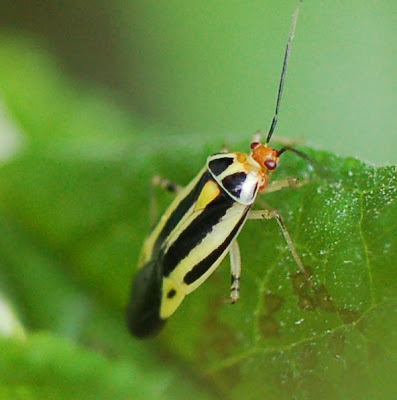
Every spring, little mirids work over my butterfly bush, sucking juice out of the tender new leaves as they expand. Lopidea and Halticus species usually hit it, and this pretty bug, Poecilocapsus lineatus is all over it as well. This year, our April cold snap knocked back the populations of these early garden pests, but they're still here in reduced numbers.
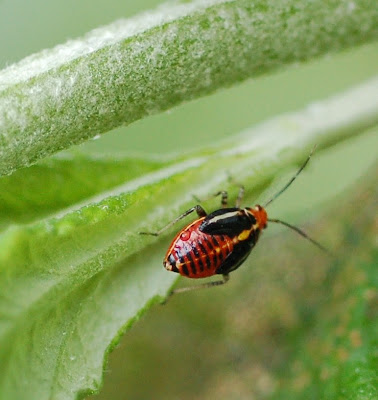
The Poecilocapsus nymphs are pretty, too, although I find their color incongruous with the adults.



I had a wonderful time at the Maury River Fiddler's Convention in Buena Vista, Virginia over the weekend. I got to play the concertina quite a bit, and I thought it was working pretty well with the string band instruments. I noticed this box in the trash there, though, and it puzzled me. "Generation 7 Fries Concertina Frozen Potatoes." Are they Concertina-Frozen potatoes or Concertina-Potatoes, sold frozen?
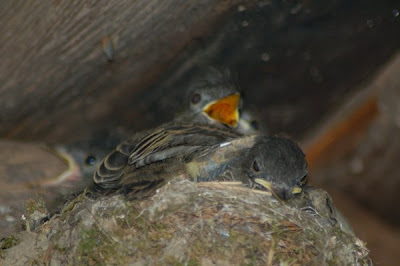
The phoebe babies are growing fast, but are still in the nest, expecting to be fed. After my controversial comment about Wood Thrush song last month, I hunted down a few bird call resources on the Web. Here are the ones I found most usable.

Over the weekend, we went to Virginia for the Maury River Fiddler's Convention. It's fun to go to festivals, but it's also very nice to come home to Droop Mountain.

I saw this pretty narrow-winged damselfly in the grass a few days ago. Dragonflies and damselflies are much beloved insects, the North American fauna has relatively few species (compared to beetles or leafhoppers or moths), and the insects themselves are large enough to be identified without magnification. That's why I wasn't surprised to find lots of Internet resources for their identification, including two checklists to odonate fauna of West Virginia. Wildlife photographer Stephen Cresswell has a Checklist of the Damselflies of West Virginia that links to his own photographs of most of the listed species, and the USGS Northern Prairie Wildlife Research Center's Odonata of West Virginia includes county distribution maps for each species. I don't have the insect in hand, so I won't offer an identification, but this damselfly looks much like the genus whose common name is "dancer."

A pair of phoebes start a nest on or about our woodshed every spring, but every year, Princess has persuaded them to give up the adventure--until this year. This phoebe, the female, I think, has a small grasshopper, which she is about to take into the shed.

The well-fed nestlings are almost too big for their bed, and must flop over the sides to nap. In April, we also hear wood peewees around the house. They look very much like phoebes, and we have spent a lot of time trying to decide who is who. The nest is the clincher, but this close look is helpful too. The phoebe, of course, has a good look at us, as well.


I interrupted these two tater bugs in the act of making more tater bugs on a solenaceous weed (some sort of Physalis, I think) last week. I've found several adults in the yard recently, although our taters are just coming up now. I should be more specific--Colorado Potato Beetles are one of several insects known as "tater bugs," but for me they are the true tater bug type. While they haven't yet attacked our small potatoes, I've picked some adults and eggs off our Hillbilly tomatoes, a variety described as a "potato-leaf tomato." They haven't bothered the other tomato varieties, leading me to believe that tater bugs read the fine print on seed packets.

When I was a kid, my parents subscribed to the opinion offered by the University of Kentucky College of Agriculture "Colorado Potato Beetle Management" fact sheet:
Other non-chemical control measures such as hand picking of adult beetles and immature stages is encouraged as this will aid to delay the development of resistance. Hand picking can be particularly effective in reducing the numbers of overwintering beetles coming to the young plants in the spring.As a small child with nothing better (by adult standards) to do, I spent quality time in the garden, picking these chunky chrysomelid beetles off potato plants and dropping them in a can with some kerosene in the bottom. (Soapy water works well, too, and is probably better for the younger set.) That's the origin of my fascination. The dark spots on the pronotum (that's the brown band behind the head) are variable from individual to individual, and some of them look like letters. I used to study the tater bugs, trying to spell out the message encoded in their heiroglyphs.
In the side view, you can see why the old-fashioned, arch-back mandolins are called "tater bugs" in these parts.


More from the Friday night porch light session: This sphinx moth would normally have been the star of the show, if not for the huge Polyphemus moth. Although I poked and prodded it, and crawled around on the rain-soaked porch, I was unable to persuade this sphingid to show its hindwings, or angle about so I could catch its vivid red eye-shine with the camera flash. Still, it's a big, elegant moth, in rich shades of brown.

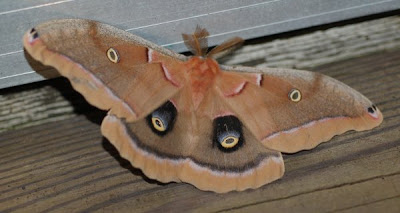
Friday's late afternoon thunderstorm was followed by a flock of moths at the porch light. This Polyphemus moth was the most spectacular. I am always thrilled to see the "Giant Silk Moths."
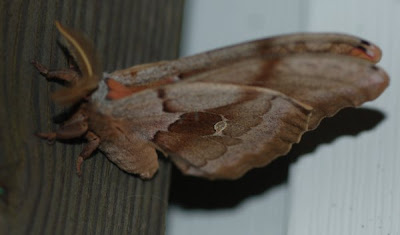
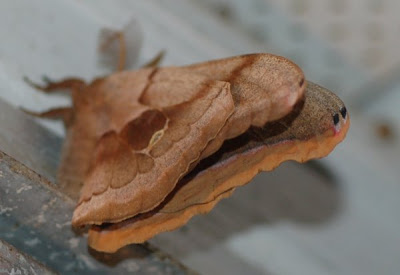

Cosmopepla bimaculata is another aposomatically colored true bug. Many members of the Pentotomidae, or "stink bugs" are cryptically colored, but some are spectacular. The only thing that keeps Cosmopepla off the "spectacular stink bug" list is its small size--it's about half a centimeter long, and unless you're looking for the beautiful red spots, all you see is a black speck. Here he's perched on a dandelion leaf, next to the Halticus whose picture I posted a few days ago.
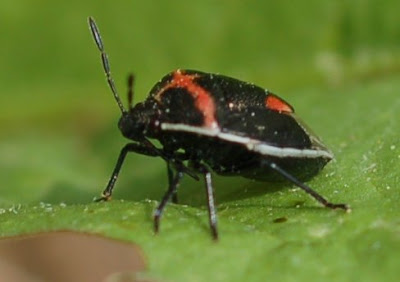
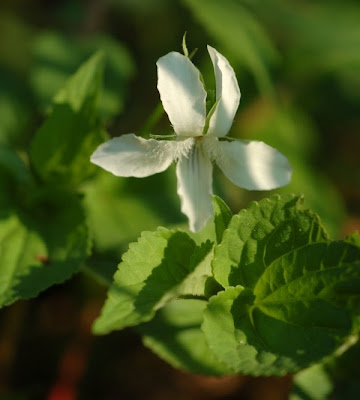
Dorothy Parker was my childhood idol, which perhaps tells you more about me than I would willingly reveal. I never see violets without thinking of her poem:
Sweet Violets You are brief and frail and blue-- Little sisters, I am too. You are Heaven's masterpieces-- Little loves, the likeness ceases.

We finally got the garden out last week. I'd blogged about my tomato seeds in April, and I got a very good germination rate from the Seedsavers seeds--much better than I usually get from the standard commercial seed catalog products. The Seedsavers broccoli also did very well.
 Calabrese Broccoli
Calabrese Broccoli Brought to America by Italian immigrants in the 1880s. Popular market variety. Tight heads can grow up to 8" in diameter. After the central head is harvested, side shoots follow. 58-90 days from transplant.
Tomatoes and broccoli are looking very good in the garden now. We also planted Seedsavers beans and squash seeds. It's too early to expect to see them come up, but I go out to the garden and look several times a day.
 Black Valentine Beans
Black Valentine Beans Introduced in 1897 by Peter Henderson & Company. Shiny black seeds and 6" pods. Excellent for use as a fresh snap bean or a dry soup bean. Prolific and dependable plants produce pods borne above the foliage. Bush habit, 49-55 days.
 Cherokee Trail of Tears Bean
Cherokee Trail of Tears Bean Given to SSE in 1977 by the late Dr. John Wyche, SSE member from Hugo, OK. Dr. Wyche's Cherokee ancestors carried this bean over the Trail of Tears, the infamous winter death march from October 1838 in the Smoky Mountains to March 26, 1839 in Oklahoma, leaving a trail of 4,000 graves. Shiny jet-black seeds. Green 6" pods with purple overlay, good for snaps and dry beans. Pole habit, 85 days.
In addition to these two bean varieties, our neighbor gave us some seeds from his "Logan Giants" pole beans. We've eaten these in previous years, and I really like them. I overdid it with squash this year, and because these three varieties are all the same species, Cucurbitus pepo, they will cross-pollinate, and I won't be able to save seeds from them. However, it will be a chance to decide what squash we like the best.
 Fordhook Acorn Squash
Fordhook Acorn Squash (C. pepo) Introduced in 1890 by W. Atlee Burpee of Philadelphia and named for their Fordhook trial grounds at Doylestown, Pennsylvania. Vining plants with long fruits similar to acorns. Can be eaten fresh around 56 days and used for baking after 85 days. Fruits seldom weigh more than two pounds. Very hard to find.
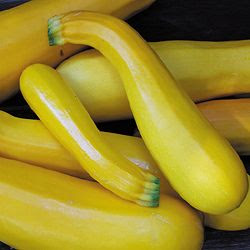 Golden Zucchini Squash
Golden Zucchini Squash (C. pepo) Developed by breeders at W. Atlee Burpee from material supplied by Dr. Ovid Shifriss at Rutgers, introduced in 1973. Glossy golden-yellow, cylindrical fruits on productive, compact bush plants. A great addition to any farm market stand or home garden. 50-55 days.
 Summer Crookneck Squash
Summer Crookneck Squash (C. pepo) Semi-open bush plants produce extended heavy crops of smooth light yellow fruits with curved necks, bumped developed after edible stage. Best eaten when 5-6" long. Creamy-white sweet mild flesh has excellent flavor. Keep picked clean to enjoy all season. 55-60 days.